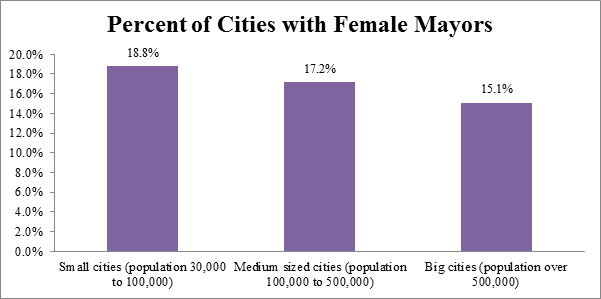Madame Mayor: Women’s Representation in Local Politics
In 1887, Mayor Susanna Salter became the first woman to hold elected office in the United States. Indeed, several women served in local office across the country before women gained the national right to vote. Today, more than 150 years later, only 18.4% of mayors of cities with populations over 30,000 are women (CAWP, US Conference of Mayors). Women are only slightly better represented on city councils, holding 26% of city council seats in the United States.
Where women are elected to mayorships correlates with the size of their cities. The vast majority of female mayors serve in cities with populations less than 100,000, and the proportion of female mayors decreases as city populations increase. This is consistent with the general finding that voters are more likely to support female candidates running for less prestigious offices.

Muriel Bowser, the recently elected mayor of D.C. (the city’s second-ever female mayor), joins a select group of high-profile women serving in large cities. Only six cities with a 500,000+ population—Baltimore, Fort Worth, Houston, Las Vegas, Minneapolis, and D.C.—have female mayors.
Women’s underrepresentation in urban politics is troubling for several reasons.
- Mayor and city council positions are primary pipeline offices for state and national seats. Women serving at the local level often go on to serve in higher levels of office. Indeed, serving in local office can provide women with the connections and skills necessary to win larger races. Female mayors and city council members are also able to learn political skills like drafting legislation, meeting with constituents, and managing resources that serve them well in state and national offices.
- Women in local office can also serve as role models for other women thinking about running for political office. The absence of female mayors and city councilmembers reinforces perceptions that politics is a “man’s game” and discourages women’s political ambition.
- Women in local office change policy outcomes, especially in areas that matter to women. Muriel Bowser, in her victory speech, noted her commitment to “a level playing field for women”—Bowser’s emphasis on women’s issues is representative of how women in local office champion their communities.
To advance women to the highest levels of public office in the United States, we need to support women in accessing key posts—like city mayorships—that serve to launch careers in higher offices. These offices provide opportunities for women to learn executive governing skills, demonstrate their ability to win elections and handle the duties of political offices, and build a positive reputation with voters. All of these factors can contribute to women winning offices at all levels in the United States.
Mirya R. Holman is an Assistant Professor of Political Science at Florida Atlantic University. Her book Women in Politics in the American City (Temple University Press 2014) is a comprehensive evaluation of the ways in which gender matters in local politics. She tweets about women’s and local political issues at @prof_mirya.
